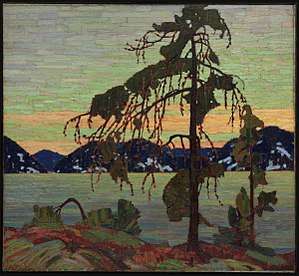Frederick Varley
Frederick Horsman Varley (January 2, 1881 – September 8, 1969) was a member of the Canadian Group of Seven artists.
Frederick Varley | |
|---|---|
 | |
| Born | Frederick Horsman Varley January 2, 1881 |
| Died | September 8, 1969 (aged 88) |
| Nationality | Canadian |
| Known for | Painting |
| Movement | Group of Seven |
Life
Early life
Varley was born in Sheffield, England,[1] in 1881, the son of Lucy (Barstow) and Samuel Joseph Bloom Varley.[2] He studied art in Sheffield and attended Académie royale des Beaux-Arts in Antwerp, Belgium, where he worked on the docks. He immigrated to Canada in 1912 on the advice of another Sheffield native (and future Group of Seven member), Arthur Lismer, and found work at the Grip Ltd. design firm in Toronto, Ontario.[3]
War artist

Beginning in January 1918, he served in the First World War with C.W. Simpson, J.W. Beatty and Maurice Cullen.[4] Varley came to the attention of Lord Beaverbrook, who arranged for him to be commissioned as an official war artist.[5] He accompanied Canadian troops in the Hundred Days offensive from Amiens, France to Mons, Belgium. His paintings of combat are based on his experiences at the front. Although he had been enthusiastic to travel to France as a war artist, he became deeply disturbed by what he saw:
We’d be healthier to forget [the war], and that we never can. We are forever tainted with its abortiveness and its cruel drama.[6]
Varley's Some Day the People Will Return, shown at Burlington House in London and at the Canadian War Memorials Exhibition, is a large canvas depicting a war-ravaged cemetery, suggestive that even the dead cannot escape the destruction.[4]
Group of Seven

In 1920, he was a founding member of the Group of Seven. He was the only original member of the Group of Seven to specialize in portraiture, but he also painted landscapes. Varley's major contribution to art is his work with the Group of Seven and his portraits.
Later life and death
After living in Ontario for a number of years, Varley moved to Vancouver, BC in 1926 where he became Head of the Department of Drawing and Painting at the School of Decorative and Applied Arts in Vancouver at the invitation of Charles Hepburn Scott. He remained in this position from 1926 until 1933.[7] He left British Columbia in 1936 due to his experiences with depression, and two years later joined fellow artists on a trip to the Arctic in 1938. In 1954, along with a handful of artists including Eric Aldwinckle, he visited the Soviet Union on the first cultural exchange of the Cold War.[8]
He died in Toronto in 1969 and was buried alongside other members of the Original Seven at the McMichael Canadian Art Collection grounds in Kleinburg, Ontario.
Recognition
Varley was a member of the Royal Canadian Academy of Arts.[9]
In Unionville, the Varley Art Gallery of Markham is named after him, as is Fred Varley Drive, a two-lane residential street. Varley lived nearby at the Salem-Eckhardt House from 1952 to 1969.[10]
On 6 May 1994 Canada Post issued 'Vera (detail), F.H. Varley, 1931' in the Masterpieces of Canadian art series. The stamp was designed by Pierre-Yves Pelletier based on an oil painting "Vera", (1931) by Frederick Horsman Varley in the National Gallery of Canada, Ottawa, Ontario. The 88¢ stamps are perforated 14 x 14.5 and were printed by Leigh-Mardon Pty Limited.[11]
His secure place in the art history of Canada is verified by the government's decision to reproduce his self-portrait as a 17-cent postage stamp. On 22 May 1981 Canada Post issued 'Frederick H. Varley, Self Portrait' designed by Pierre Fontaine. The stamps are based on an oil painting "Self Portrait", (circa 1945) by Frederick Horsman Varley in the Hart House Permanent Collection, University of Toronto, Toronto, Ontario. The 17¢ stamps are perforated 12.5 and were printed by Ashton-Potter Limited.[3]
Selected works
 German prisoners on the Western Front.
German prisoners on the Western Front. Gas chamber at Seaford
Gas chamber at Seaford The Young Man's Element, the Air
The Young Man's Element, the Air
Notes
- Reid, Dennis R. (1988). A Concise History of Canadian Painting, p. 142.
- Canada Post stamp
- Davis, Ann. (1992). The Logic of Ecstasy: Canadian Mystical Painting, 1920–1940, p. 30., p. 30, at Google Books
- Brandon, Laura. (2008). Art and War, p. 46., p. 46, at Google Books
- Artinthepicture.com, Introduction to Art History, Fred Varley quotes
- "Frederick H. Varley". The Art History Archive. The Lilith eZine. Retrieved 19 September 2015.
- "F.H. Varley 1881 - 1969". National Gallery of Canada. National Gallery of Canada. Retrieved 19 September 2015.
- "Members since 1880". Royal Canadian Academy of Arts. Archived from the original on 26 May 2011. Retrieved 11 September 2013.
- http://www.historicplaces.ca/en/rep-reg/place-lieu.aspx?id=15234
- Post stamp
References
- Boulet, Roger; Group of Seven and Tom Thomson (1982), The Canadian Earth, M. Bernard Loates, Cerebrus Publishing
- Brandon, Laura. (2008). Art and War. New York: I.B. Tauris. ISBN 9781845112370; OCLC 225345535
- Davis, Ann (1992). The logic of ecstasy: Canadian mystical painting, 1920–1940. Toronto: University of Toronto Press. ISBN 9780802059161; ISBN 9780802068613; OCLC 26256269
- Reid, Dennis R. (1988). A Concise History of Canadian Painting. Toronto: Oxford University Press. ISBN 9780195406641; ISBN 978-0-19-540663-4; OCLC 18378555
Further reading
- Atanassova, Katerina (2008). F.H. Varley: Portraits Into the Light/Mise en Lumière Des Portraits. Dundurn Press Ltd. ISBN 9781550029093.CS1 maint: ref=harv (link)
External links
| Wikimedia Commons has media related to Frederick Varley. |
- Works by or about Frederick Varley at Internet Archive
- Biography at the Tom Thomson Memorial Art Gallery
- Frederick Varley at artcyclopedia.com
- CBC Digital Archives - The Group of Seven: Painters in the Wilderness
- Watch the NFB documentary Varley
- Varley Art Gallery of Markham, Ontario
